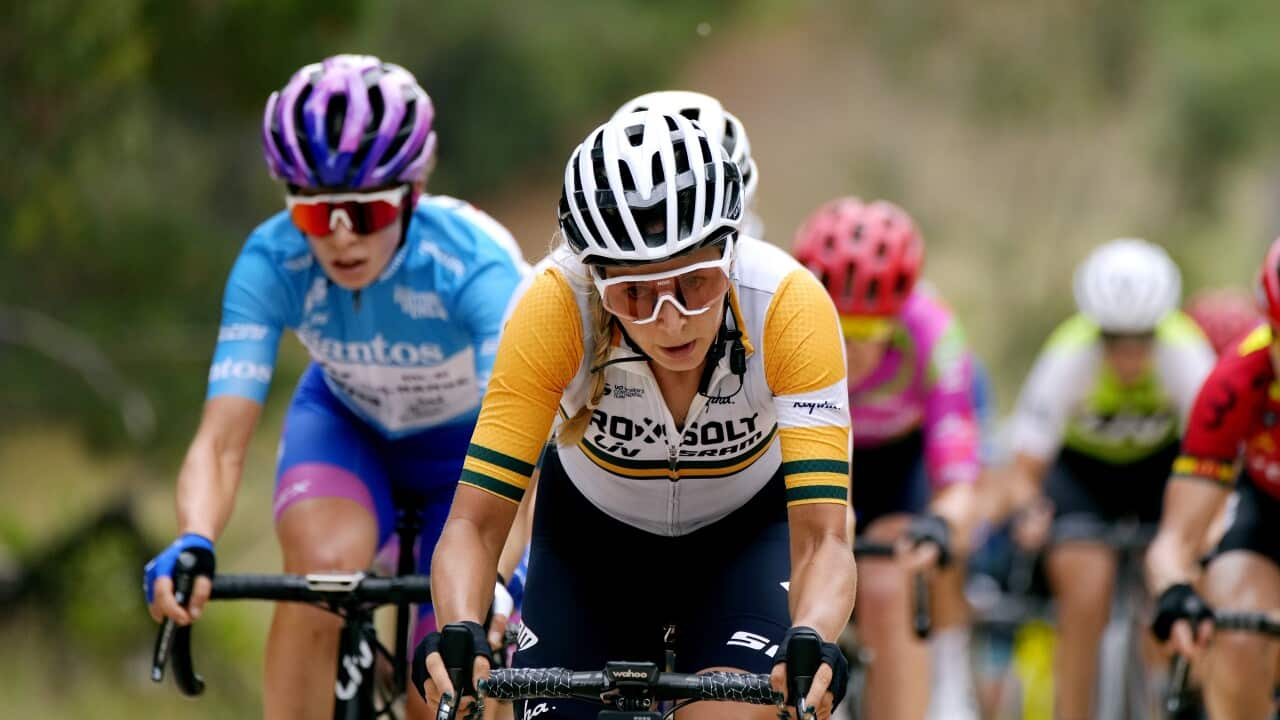WATCH the 2022 Tour de France Femmes avec Zwift LIVE and EXCLUSIVE on SBS, SBS On Demand and the SBS ŠKODA Tour Tracker App from 9:30pm (AEST) on July 24.
It was a whirlwind moment from domestic racing against a small field in Australia to the hype of riding in the midst of a full Tour de France crowd that saw Kathy Watt live and breathe cycling for the next few decades of her life.
“I went from the two-day Tour of Canberra, which had 25 riders to the Tour de France,” said Kathy Watt in an interview with SBS Sport. “We raced 5 mins behind the men, had the same crowds on the side of the road, stayed in the same accommodation, I was hooked on cycling then!”
The Tour de France Féminin was started in 1984 by ASO, the Tour de France men’s organisers, as a full three-week race running alongside the men’s race. By 1988, it was a two-week race, following the men’s route, with all the fans out roadside staying to cheer on the women tackling the course.

Kathy Watt (2nd from right) being presented with the Australian team at the 1988 Tour de France Feminin.
“When I got over there, I went out to recon the course around Strasbourg,” said Watt. “I got a little lost and got found by a group of local cyclists, who then became a fan club for the first few stages of the Tour.”
“I would get just dropped on the climbs and then descend back to the top few riders on the descent. There were some riders who were very strong but not so skilled in the bunch and (Jeannie) Longo was yelling at people to move out of the way, so I quickly learned to stay clear of the bunch!
“We had a great team of Australians with Liz Hepple and Donna Gould and I could ask them for tips and learned as you go.”

1988 Tour de France Feminin with Australian squad featuring Robyn Battison, Donna Rae-Szalinksi, Marisa Gori, Liz Hepple, Donna Gould, Kath Shannon and Kathy Watt. Watt's first race in Europe finishing 7th on GC after finishing on Champs Elysees. (Supplied by Kathy Watt)
“It was so exciting when we went through the tunnel and then onto the Champs-Élysées,” said Watt. “There was not internet back then, but the riders had talked about it and I knew there was this tunnel before the entry to the Champs Elysees. I got excited and went for one of the sprints and then all of sudden there were riders down all across the road and I came down.”
In the confusion of the crash, the Australian team car drove past, leaving Watt stranded until a spectator jumped the fence to aid her and then she was in the midst of the Russian national team driving back into contention to make contact with the peloton.
“I was back on with the Russian world team time trial team,” said Watt. “We were working together with the Russian coach yelling at us from the car.
“Normally you couldn’t catch up with the bunch, but it was such a fast pace that we got back on. Then with two laps I talked to Liz and Donna and asked if they wanted to have a go at the sprint.
“They said ‘no’, so I went up the front and then everyone fell again within 200 metres. I finished seventh, bouncing back up after crashing, you bounce at that age. That was my first Tour de France.”
Watt finished seventh overall, an impressive achievement given her inexperience at that level of competition, that same year fellow Australian cycling trailblazer Elisabeth Hepple finished third behind one of the greatest cyclists of all time in Jeannie Longo. Watt would race for decades in Europe and on the World Cup circuit and win Australian national championships on the road, on the track and in mountain bike.
It was a different era, lacking the team support that riders take for granted from their support staff these days, even having to resort to unusual methods to avoid the heat in the height of summer of southern France.
“Your toenails would go black from the heat, there were signs on the road warning of 50 degree heat, sometimes you had to be careful that you didn’t stick to the road,” said Watt. “I used to go into McDonalds after stages, a lot of people thought I was getting a burger, but I’d maybe get an orange juice and get some ice.
“Ice was a rarity those days and one of the only places to get it was at McDonalds. I’d get some in bags for my knees, legs or down my back if the car didn’t have air-conditioning.”
The 1998 Grande Boucle was another landmark moment for the sport, the Tour de France Féminin wasn’t called that any more due to a copyright dispute with the men’s race organisers and it changed its name from 1990 through 1993 to the Tour of the EEC Women; from 1992 through 1997 to the Tour Cycliste Féminin; to La Grande Boucle Féminin Internationale from 1998 until 2004; and then the Grande Boucle Féminin from 2004 to 2010.
The 1998 edition was significant as Watt journeyed there with the first professional team in the women’s peloton, Saturn Cycling Team from the US. The rest of the race set-up was certainly run to make a profit, with the riders arguably exploited to give the race organisers more chances to get appearance fees from local councils.
“It was brutal that year we had all these really long sections under control (pre-race neutral) so the race organiser could get extra money from all the towns,” said Watt. “You had rules for how long stages could be and these under control sections would add 15 or 20 kilometres, maybe more. Then there were all these double stages, I think there were three that year.
“I remember we finished one stage on top of a mountain. Other teams got off the mountain, but our team director decided to stay up there and have a massage up there. A French crowd gathered around us, turned out there was a cheese-making place up there, we were eating sandwiches, getting massages and our teammate from Burkina Faso, put a skirt on, dropped her knicks and was praying to Allah on top of the mountain. I wish I had my camera that day.”
The Australian champion watches the current generation, particularly during the classics and approves of most of the development in the sport over that time while pointing out the shortfalls.
“The brilliant part about it is that we’re seeing more and more support and infrastructure,” said Watt. “There’s much more support at the race and riders can now earn a wage. There’s a way to go in recognition in the media and profile.
“In some respects when we raced it, it was ahead of where it is now. We used to race 10 days.”
For Watt, there are a lot of vivid memories associated with racing the various editions of the women’s Tour de France, soon to find yet another tag with the inaugural Tour de France Femmes avec Zwift. While the French races were important, Watt’s crowning achievement remains the Olympic gold in Barcelona.
“Cycling was my passion, you try hard and you try to achieve things,” said Watt. “With the womens road race at the Olympics that was the pinnacle, at least from my era. It only comes around every four years and everyone tries to win. You always look back and think about things you could have done differently, but I look back and I’m happy with what I achieved.”

Kathy Watt (centre-right) is joined by Tour de France Director Christian Prudhomme (left) and Jean Francois Peschaux (right) former Director of both mens & Womens Tour de France for a champagne toast on Bastille Day.
“I’m planning to watch, and eventually go back and cover the Tour de France,” said Watt. “I’m sure there will be good racing, and hopefully it gets good coverage and can grow in days of racing back to where it was before.”
WATCH the 2022 Tour de France Femmes avec Zwift LIVE and EXCLUSIVE on SBS, SBS On Demand and the SBS ŠKODA Tour Tracker App from 9:30pm (AEST) on July 24. We will also broadcast the Teams Presentation from 7:20pm (AEST) on July 24 LIVE via SBS On Demand.












